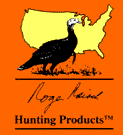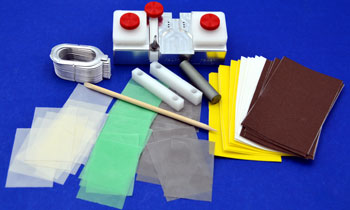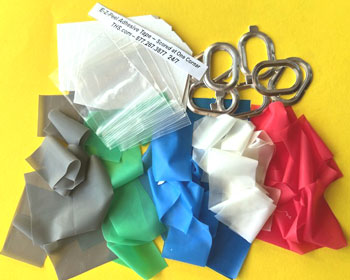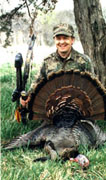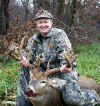Turkey calling is
the most confusing and frustrating part of turkey hunting for many hunters, even
experienced ones. Turkeys make dozens of calls or
sounds, but you don't need to know them all to be successful.
|
Master the cluck, yelp and
purr, with a few variations and you're ready for the woods.
|
Calling is the most
overrated part of turkey hunting, although the part that most hunters focus on. No secret calling sequence or calling device is guaranteed to "bring
em' in" every time.
|
There are three SECRETS to turkey calling strategy:
|
Know how to effectively
operate your calls.
Make the right call at the
right time.
Call to a gobbler that is by
himself....one that hopefully wants company.
|
Calling A Roosted Gobbler
|
I recommend a
standard approach to calling a roosted gobbler. Let him know you're a hen just
waking up and looking for company. Play a little hard to get
to start off.
|
Begin with a few soft tree yelps, a cluck or two and purrs...just
what he expects to hear from a hen on roost.
|
If he answers with a
gobble, wait 10 minutes before calling again. Repeat the call if he's still in the
tree after 10 minutes.
|
If he answers again, put
the call down. You'll know that he's still in the tree by the sound of his
gobble. It will sound strong, clear and all from the same location.
|
Don't call too much
to him when he's in the tree. You want him to come
down. By calling too much, he generally prolongs his stay on roost, making him
gobble more, which attracts hens or other hunters and lets him know precisely where you
are. He expects you to come to him.
|
When you see or hear
him fly down or if the next gobble sounds muffled but in the same general direction, you
should assume that he is on the ground. Immediately make a
fly-down cackle, followed with a short series of yelps or cutts.
|
If he gobbles at
that, you have his attention. What you want to hear now
is his gobbling getting closer and closer as he moves towards you. And...sometimes
it actually happens that way!
|
If you hear him spitting
and drumming, he's almost in gun range. Make a few soft clucks and purrs to let him
know you are close too. That is what he expects to hear.
|
What If
He Doesn't Walk Right In?
|
What to do if he doesn't
come right in?
|
There is no secret
call or tactic to drag him in, despite what the call manufacturers tell you. Each situation is different. Each
bird is unique and will respond to different calls in different ways.
|
Turkey calling is very
much an art. It helps to have a lot of experience. But...be patient if he
doesn't prance right up to your location.
|
If he's getting
closer, but not coming in very fast, make no move. Keep calling patiently about
every 5 minutes or so. Try to sound like an excited hen
with snappy, yelps, clucks and cutts with an occasional cackle. Don't give up on a slow moving gobbler for at least an hour.
|
Call only loud
enough for him to hear you. If you call too loudly, he
will think you should move towards him. Keep your calls low at this point...make
him curious.
|
Call often enough to
keep his attention. If he is gobbling several times a
minute, and some will first thing in the morning before they join up with hens, it's a
mistake to answer every gobble.
|
I like to answer him
about one time per minute. But, if he's gobbling only about
once per minute, I'll answer every gobble early in the morning.
|
And...I suggest you
wait to hear him gobble and then answer him. In this
way, you know exactly where he is and it will help you make the decision on how to
respond. It's fun to call and have him answer, but I prefer to know his location
before I call, because he may have approached and be in my lap and a loud call to him at
that time may cause him to hang up.
|
How To Call If
He Still Won't Come In?
|
As long as he is still
gobbling I remain in my position unless I know I'm too far away or there is an obstacle
between the bird and my location. Then I'll move quickly to a better set up before
proceeding to call more.
|
Assuming you think
you are located correctly, which is the real SECRET to calling, be patient with your
calls. Be adaptable.
|
Try soft calls...like
purrs, whines, and clucks and yelps to try to fool the bird into thinking you have moved
farther away.
|
If that doesn't work, try
to sound like an obnoxious, excited hen with loud yelps, and cutts. I'll try to
sound like more than one hen. Use a mouth call and a friction call to imitate two
birds talking to each other. Sometimes this drives gobblers crazy. I don't
call when a bird can see me, unless I'm trying to coax him in the last few yards.
I'll use soft clucks and purrs mostly.
|
There are many reasons why
a gobbler won't come to your calls....and most of the time it's not your poor
calling. The best callers in America will have no better luck calling gobblers than
you will. It mostly depends on the situation.
|
For example, if he has
hens with him, it's doubtful that you can drag him away. Or even if he's alone, he
may hang up. I usually try a period of the "silent treatment" on a gobbler
that has been answering me and won't come in.
|
And....later really crank
it up and call almost constantly for a minute or so to sound like a lost, excited
bird....to try to get him stimulated to gobble and make him move in.
|
No matter what you do,
many gobblers will simply slip away and you'll feel defeated.
|
Don't be
discouraged...this happens to all of us. The same calls that failed today may work
nicely tomorrow on a different bird or the same bird.
|
Strategy for
Hung Up and Silent Gobblers
|
Try these three tactics
for any silent gobbler or one that hangs up or won't come to you after an hour of
calling.
|
Give him the
"silent treatment" for about 20 minutes. He's
been hearing you call every 5 to 10 minutes for an hour. Now shut up. He may
get curious and come over to investigate.
|
Be prepared for him to
walk in silently, like a ghost.
|
If that doesn't
work, try calling a lot...you've got nothing to lose.
|
Try to fire him up with
excited cackles, cutting, and yelps. Give this approach about 15 minutes.
You're generally trying to simply stimulate him into gobbling so you know where he is and
to excite him into doing something.
|
If he answers, work him
normally.
|
The last resort is
to move. But....don't move if he's getting closer, even
if it is very slowly. Don't move if you can hear spitting and drumming....he's very
close...stay where you are. If you get him to gobble, even once, and he shuts up
again, be on the alert for him to come to you silently.
|
You'll
Eventually Decide To Move
|
If you decide to
move, make one more excited series of calls to try to stimulate him into gobbling so you
know where he is. When moving, do it quickly, quietly and stay out of sight. Move into another, better position.
|
If he's been close...say
100 yards or so, move back 50 to 100 yards and try calling again. Make him think you
are leaving.
|
If he's far away, try to
cut the distance in half. Keep using the same calling patterns you did before.
|
If the bird is on
another ridge or has been moving away from you, stay with him as long as possible.
Move in closer but stay out of sight. Trying to get ahead of a gobbler to intercept
him is often said to be the best policy, but I find it difficult to predict where he's
going. I prefer to bring up the rear, and stay with him
because eventually he will stop and set up shop in a new Strut Zone and then I'll make my final adjustment of position.
|
There are times when
you need to move quickly.
|
If you hear gobbling from
the other side of an obstacle like a fence, ravine, or heavy brush and he seems to be
pacing back and forth over a hundred yard distance or so, you can get up and move to the
end of his pattern when he's on the other end, but this is easier said than done.
|
If he's on a
different ridge than you are, it's best to move to his ridge. Turkeys will come across obstacles, but most hunters don't have the
patience to wait that long. If he's clearly leaving,
every gobble getting farther away, get up and move so you can stay with him.
|
And...finally, after
at least an hour of calling from one spot, you may want to move to another spot,
especially if you heard gobbling from it earlier.
|
The best advice on calling
strategy is to select the proper strut zone and stay there for several hours. I
strongly believe that hunting in no more than two good spots each morning will produce
more consistent results than moving every hour or so. |
